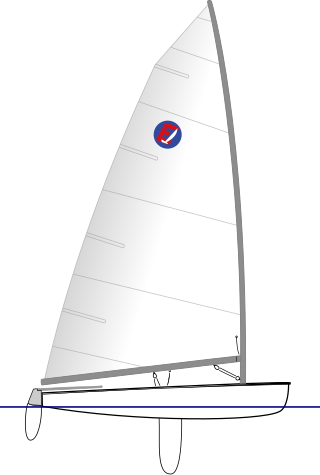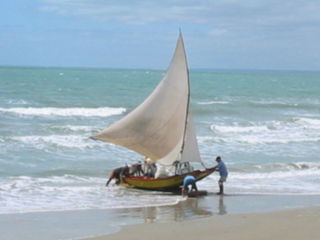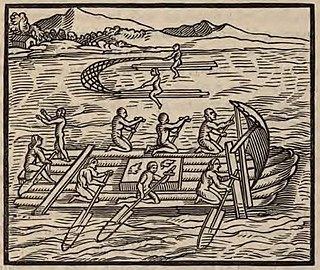Related Research Articles

A maraca, sometimes called shaker or chac-chac, is a rattle which appears in many genres of Caribbean and Latin music. It is shaken by a handle and usually played as part of a pair.

The Kon-Tiki expedition was a 1947 journey by raft across the Pacific Ocean from South America to the Polynesian islands, led by Norwegian explorer and writer Thor Heyerdahl. The raft was named Kon-Tiki after the Inca god Viracocha, for whom "Kon-Tiki" was said to be an old name. Heyerdal’s book on the expedition was entitled The Kon-Tiki Expedition: By Raft Across the South Seas. A 1950 documentary film won the Academy Award for Best Documentary Feature. A 2012 dramatized feature film was nominated for the Academy Award for Best Foreign Language Film.

A daggerboard is a retractable centreboard used by various sailing craft. While other types of centreboard may pivot to retract, a daggerboard slides in a casing. The shape of the daggerboard converts the forward motion into a windward lift, countering the leeward push of the sail. The theoretical centre of lateral resistance is on the trailing edge of the daggerboard.

An inflatable boat is a lightweight boat constructed with its sides and bow made of flexible tubes containing pressurised gas. For smaller boats, the floor and hull are often flexible, while for boats longer than 3 metres (9.8 ft), the floor typically consists of three to five rigid plywood or aluminium sheets fixed between the tubes, but not joined rigidly together. Often the transom is rigid, providing a location and structure for mounting an outboard motor.

A centreboard or centerboard (US) is a retractable hull appendage which pivots out of a slot in the hull of a sailboat, known as a centreboard trunk (UK) or centerboard case (US). The retractability allows the centreboard to be raised to operate in shallow waters, to move the centre of lateral resistance, to reduce drag when the full area of the centreboard is not needed, or when removing the boat from the water, as when trailering. A centreboard which consists of solely a pivoting metal plate is called a centerplate. A daggerboard is similar but slides vertically rather than pivoting.

The Europe is a one-person dinghy designed in Belgium in 1960 by Alois Roland as a class legal Moth dinghy. The design later changed into its own one-design class.

De Tomaso Automobili Ltd. is an Argentine-Italian car-manufacturing company. It was founded by the Argentine-born Alejandro de Tomaso (1928–2003) in Modena in 1959. It originally produced various prototypes and racing cars, including a Formula One car for Frank Williams's team in 1970. Most of the funding for the automaker came from de Tomaso's brother-in-law, Amory Haskell Jr., Rowan Industries.

A jangada is a traditional fishing boat made of wood used in the northern region of Brazil.

The Tangaroa Expedition of 2006 closely resembled the Kon-Tiki expedition sailing a balsa raft from Peru to Polynesia. Tangaroa outperformed Kon-Tiki by having an improved sail rig and by actively using guaras (centerboards). As such, the expedition represents a scientific continuation of Thor Heyerdahl's experiments in recreated maritime technology.
Guará is a municipality in the state of São Paulo, Brazil.

Torgeir Sæverud Higraff is an explorer, teacher and author with special interest in prehistoric transoceanic contact. Like Thor Heyerdahl, Higraff combines history, anthropology and traditional knowledge with expeditions. In 2002, the year Heyerdahl died, Higraff decided to recreate the Kon-Tiki expedition, and in 2006 the Tangaroa Expedition sailed from Peru to Raiatea in eastern Polynesia. Tangaroa outperformed Kon-Tiki by using an improved sail rig and active use of the guara centerboards.

Between 1966 and 1973, Spanish explorer Vital Alsar led three expeditions to cross the Pacific Ocean by raft – La Pacífica in 1966, La Balsa in 1970 and Las Balsas in 1973. Travelling from Ecuador, South America, to Australia, the first expedition failed, but the second and third succeeded, both setting the record for the longest known raft voyages in history – 8,600 miles (13,800 km) and 9,000 miles (14,000 km) respectively.

Pre-Columbian rafts plied the Pacific Coast of South America for trade from about 100 BCE, and possibly much earlier. The 16th-century descriptions by the Spanish of the rafts used by Native Americans along the seacoasts of Peru and Ecuador has incited speculation about the seamanship of the Indians, the seaworthiness of their rafts, and the possibility that they undertook long ocean-going voyages. None of the prehistoric rafts have survived and the exact characteristics of their construction and the geographical extent of their voyages are uncertain.

Abora is the name of several reed boats built by the German explorer Dominique Görlitz. The expeditions were inspired by previous trans-oceanic expeditions by the Norwegian explorer Thor Heyerdahl. Main aim of the Abora expeditions was to prove that a keel-less reed boat could be steered crosswise and against prevailing winds, using sideboards (leeboards) in lieu of a fixed keel. The name of the vessels was derived from the Canarian deity Abora.
The Cape Cod Cat, also called the Cape Cod Cat 17 and the Hermann Cat, is an American trailerable sailboat that was designed by Charles Whittholz as a day sailer/cruiser and first built in 1968.
The Cape Cod Mercury 15, also called the Mercury Sloop and just the Mercury, is an American trailerable sailboat and sailing dinghy, that was designed by Sparkman & Stephens and first built in 1940.
The Neptune 24 is an American trailerable sailboat that was designed as a cruiser and first built in 1978.
The Nimble 25 Arctic, also called just the Nimble 25, is an American trailerable sailboat that was designed by Ted Brewer as a cruiser and first built in 1988.
The San Juan 23 is an American trailerable sailboat that was designed by Canadian Bruce Kirby and Don Clark as a cruiser and first built in 1975.
The Seafarer 24 is an American trailerable sailboat that was designed by McCurdy & Rhodes as a cruiser and first built in 1974.
References
- ↑ Sanders, R When Thor Heyerdahl was delighted to be wrong: The Case of the Guara or Centerboard, published in Fall 2003 issue of 21st Century Science & Technology, retrieved on Jan 24, 2015
- ↑ Stein, Stephen K. (2017-04-24). The Sea in World History: Exploration, Travel, and Trade [2 volumes]. ABC-CLIO. p. 214. ISBN 9781440835513.
- ↑ Abstracts of New World Archaeology. University of Utah Press. 1961. p. 168.
Inca seamen could tack and beat to windward through the use of wooden centerboards (guaras) set between cracks in the log rafts.